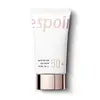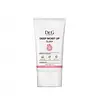What's inside
What's inside
 Key Ingredients
Key Ingredients

 Benefits
Benefits

 Concerns
Concerns

 Ingredients Side-by-side
Ingredients Side-by-side

Water
Skin ConditioningButylene Glycol
HumectantC12-15 Alkyl Benzoate
AntimicrobialEthylhexyl Methoxycinnamate
UV AbsorberTitanium Dioxide
Cosmetic ColorantDiethylamino Hydroxybenzoyl Hexyl Benzoate
UV FilterBis-Ethylhexyloxyphenol Methoxyphenyl Triazine
Skin ConditioningCyclopentasiloxane
EmollientSilica
AbrasiveCyclohexasiloxane
EmollientTocopheryl Acetate
AntioxidantAlthaea Officinalis Root Extract
Skin ConditioningLavandula Angustifolia Extract
Skin ConditioningAnthemis Nobilis Flower Extract
MaskingCentella Asiatica Extract
CleansingLippia Citriodora Leaf Extract
AstringentAloe Barbadensis Leaf Extract
EmollientMagnesium Aspartate
Skin ConditioningZinc Gluconate
Skin ConditioningCalcium Gluconate
HumectantCopper Gluconate
Skin ConditioningPhenyl Trimethicone
Skin ConditioningAluminum Stearate
Cosmetic ColorantPolyacrylate-13
Polyhydroxystearic Acid
EmulsifyingAlumina
AbrasivePolyisobutene
Stearic Acid
CleansingGlyceryl Caprylate
EmollientCarbomer
Emulsion StabilisingEthylhexylglycerin
Skin ConditioningPolysorbate 20
EmulsifyingDisodium EDTA
Phenoxyethanol
PreservativeCI 77491
Cosmetic ColorantCI 77492
Cosmetic ColorantParfum
MaskingWater, Butylene Glycol, C12-15 Alkyl Benzoate, Ethylhexyl Methoxycinnamate, Titanium Dioxide, Diethylamino Hydroxybenzoyl Hexyl Benzoate, Bis-Ethylhexyloxyphenol Methoxyphenyl Triazine, Cyclopentasiloxane, Silica, Cyclohexasiloxane, Tocopheryl Acetate, Althaea Officinalis Root Extract, Lavandula Angustifolia Extract, Anthemis Nobilis Flower Extract, Centella Asiatica Extract, Lippia Citriodora Leaf Extract, Aloe Barbadensis Leaf Extract, Magnesium Aspartate, Zinc Gluconate, Calcium Gluconate, Copper Gluconate, Phenyl Trimethicone, Aluminum Stearate, Polyacrylate-13, Polyhydroxystearic Acid, Alumina, Polyisobutene, Stearic Acid, Glyceryl Caprylate, Carbomer, Ethylhexylglycerin, Polysorbate 20, Disodium EDTA, Phenoxyethanol, CI 77491, CI 77492, Parfum
Water
Skin ConditioningEthylhexyl Methoxycinnamate
UV AbsorberButylene Glycol
HumectantEthylhexyl Salicylate
UV AbsorberAlcohol
AntimicrobialC12-15 Alkyl Benzoate
AntimicrobialDiethylamino Hydroxybenzoyl Hexyl Benzoate
UV FilterHomosalate
Skin ConditioningOctocrylene
UV AbsorberCI 77891
Cosmetic Colorant1,2-Hexanediol
Skin ConditioningNiacinamide
SmoothingCetyl Ethylhexanoate
EmollientC20-22 Alkyl Phosphate
EmulsifyingC20-22 Alcohols
Emulsion StabilisingCaprylyl Methicone
Skin ConditioningGlyceryl Stearate
EmollientBehenyl Alcohol
EmollientSilica
AbrasiveAluminum Stearate
Cosmetic ColorantSodium Acrylate/Sodium Acryloyldimethyl Taurate Copolymer
Emulsion StabilisingTromethamine
BufferingPolyhydroxystearic Acid
EmulsifyingPolyisobutene
Propanediol
SolventPolyacrylate Crosspolymer-6
Emulsion StabilisingAlumina
AbrasiveGlyceryl Caprylate
EmollientSaccharide Hydrolysate
HumectantEthylhexylglycerin
Skin ConditioningOctyldodecanol
EmollientXanthan Gum
EmulsifyingCitrus Aurantium Bergamia Fruit Oil
MaskingOlea Europaea Oil Unsaponifiables
Skin ConditioningPelargonium Graveolens Flower Oil
MaskingAdenosine
Skin ConditioningTriticum Vulgare Germ Oil Unsaponifiables
EmollientSorbitan Oleate
EmulsifyingCaprylyl/Capryl Glucoside
CleansingGlycine Soja Oil Unsaponifiables
EmollientCurcuma Longa Root Extract
MaskingPortulaca Oleracea Extract
Skin ConditioningCentella Asiatica Extract
CleansingEchium Plantagineum Seed Oil
Skin ConditioningHouttuynia Cordata Extract
Skin ConditioningSalvia Hispanica Seed Extract
EmollientSodium Hyaluronate
HumectantPollen Extract
EmollientSalvia Officinalis Oil
MaskingT-Butyl Alcohol
PerfumingPogostemon Cablin Leaf Oil
MaskingCardiospermum Halicacabum Flower/Leaf/Vine Extract
Skin ConditioningHelianthus Annuus Seed Oil Unsaponifiables
EmollientCeramide NP
Skin ConditioningCholesterol
EmollientHydroxypropyltrimonium Hyaluronate
Hydrolyzed Hyaluronic Acid
HumectantCaprylic/Capric Triglyceride
MaskingTocopherol
AntioxidantLinoleic Acid
CleansingGlycine Soja Sterols
EmollientPhospholipids
Skin ConditioningBiosaccharide Gum-4
Skin ConditioningPinus Pinaster Bark Extract
AntioxidantWater, Ethylhexyl Methoxycinnamate, Butylene Glycol, Ethylhexyl Salicylate, Alcohol, C12-15 Alkyl Benzoate, Diethylamino Hydroxybenzoyl Hexyl Benzoate, Homosalate, Octocrylene, CI 77891, 1,2-Hexanediol, Niacinamide, Cetyl Ethylhexanoate, C20-22 Alkyl Phosphate, C20-22 Alcohols, Caprylyl Methicone, Glyceryl Stearate, Behenyl Alcohol, Silica, Aluminum Stearate, Sodium Acrylate/Sodium Acryloyldimethyl Taurate Copolymer, Tromethamine, Polyhydroxystearic Acid, Polyisobutene, Propanediol, Polyacrylate Crosspolymer-6, Alumina, Glyceryl Caprylate, Saccharide Hydrolysate, Ethylhexylglycerin, Octyldodecanol, Xanthan Gum, Citrus Aurantium Bergamia Fruit Oil, Olea Europaea Oil Unsaponifiables, Pelargonium Graveolens Flower Oil, Adenosine, Triticum Vulgare Germ Oil Unsaponifiables, Sorbitan Oleate, Caprylyl/Capryl Glucoside, Glycine Soja Oil Unsaponifiables, Curcuma Longa Root Extract, Portulaca Oleracea Extract, Centella Asiatica Extract, Echium Plantagineum Seed Oil, Houttuynia Cordata Extract, Salvia Hispanica Seed Extract, Sodium Hyaluronate, Pollen Extract, Salvia Officinalis Oil, T-Butyl Alcohol, Pogostemon Cablin Leaf Oil, Cardiospermum Halicacabum Flower/Leaf/Vine Extract, Helianthus Annuus Seed Oil Unsaponifiables, Ceramide NP, Cholesterol, Hydroxypropyltrimonium Hyaluronate, Hydrolyzed Hyaluronic Acid, Caprylic/Capric Triglyceride, Tocopherol, Linoleic Acid, Glycine Soja Sterols, Phospholipids, Biosaccharide Gum-4, Pinus Pinaster Bark Extract
 Reviews
Reviews

Ingredients Explained
These ingredients are found in both products.
Ingredients higher up in an ingredient list are typically present in a larger amount.
Alumina is another name for the compound aluminum oxide. It is a white powder used as a thickener, absorbent, and abrasive.
As an absorbent, alumina can give a mattifying effect. It is used in mineral sunscreens to help coat nano-sized filters, such as titanium dioxide. By increasing the size of the UV filters, these ingredients stay on the skin for a longer time. By coating small sized ingredients, alumina helps thicken a product.
Alumina may be used as an abrasive, or exfoliant.
Alumina is naturally occurring in the mineral corundum. Certain varieties of corundum create rubies and sapphires. Corundum is also the crystalline form of alumina.
Learn more about AluminaAluminum Stearate is the aluminum salt of the fatty acid, stearic acid. It is used to stabilize formulas, add thickness, and as a colorant.
Like other large lipophilic molecules, this ingredient has low dermal absorption.
Although “aluminum” in an ingredient name can raise red flags for some consumers, the form and usage context matter significantly.
For typical topical applications, there is no substantial evidence of health risks - such as cancer, neurotoxicity, or systemic “aluminum overload.”
Learn more about Aluminum StearateButylene Glycol (or BG) is used within cosmetic products for a few different reasons:
Overall, Butylene Glycol is a safe and well-rounded ingredient that works well with other ingredients.
Though this ingredient works well with most skin types, some people with sensitive skin may experience a reaction such as allergic rashes, closed comedones, or itchiness.
Learn more about Butylene GlycolC12-15 Alkyl Benzoate is made up of Benzoic Acid and long chain alcohols. It has a low molecular weight.
C12-15 Alkyl Benzoate is an emollient and texture enhancer. Due to its solubility, it is often used in sunscreens to help evenly distribute active ingredients.
As an emollient, C12-15 Alkyl Benzoate helps soften and hydrate your skin. Emollients create a film on your skin that traps moisture within.
This ingredient has been reported to cause eye irritation.
Learn more about C12-15 Alkyl BenzoateCentella Asiatica Extract (Centella) is derived from an herb native to Southeast Asia. It is famous for its anti-inflammatory and soothing properties.
Centella is rich in antioxidants and amino acids, such as Madecassic Acid and Asiaticoside.
Studies show the compounds in centella help with:
The combination of all these properties makes centella effective at soothing, hydrating, and protecting the skin.
Other great components of centella include Vitamin A, vitamin C, several B vitamins, and Asiatic Acid.
Fun fact: Centella has been used as a medicine and in food for many centuries. As a medicine, it is used to treat burns, scratches, and wounds.
Learn more about Centella Asiatica ExtractDiethylamino Hydroxybenzoyl Hexyl Benzoate (DHHB) is a chemical UV-A absorber. It is formulated for high UVA protection (320-400 nm).
DHHB is well-liked for:
DHHB has been approved by the EU, Japan, Taiwan, and South America for use up to 10%. Unfortunately, it has not been approved for use in the US or Canada due to slow regulatory processes.
This ingredient is soluble in oils, fats, and lipids.
Learn more about Diethylamino Hydroxybenzoyl Hexyl BenzoateEthylhexyl Methoxycinnamate is an organic compound that provides UVB protection. It often goes by the more common name of octinoxate. It is created from methoxycinnamic acid and 2-ethylhexanol.
Ethylhexyl Methoxycinnamate absorbs UVB rays with wavelengths between 280-320 nm. UV absorbers protect your skin by using chemical reactions to convert UV rays into heat and energy.
UVB (290-320 nm) rays emit more energy than UVA rays. They are capable of damaging DNA, causing sunburns and are thought to be linked to skin cancer.
The state of Hawaii has banned sunscreens containing octinoxate due to its potential impact on coral reefs. More research is needed to bridge gaps in this research. The European Union allows higher levels of octinoxate in sunscreens than the US and Australia.
Ethylhexyl Methoxycinnamate is oil soluble. It is not stable and may lose efficacy when exposed to sunlight.
Learn more about Ethylhexyl MethoxycinnamateEthylhexylglycerin (we can't pronounce this either) is commonly used as a preservative and skin softener. It is derived from glyceryl.
You might see Ethylhexylglycerin often paired with other preservatives such as phenoxyethanol. Ethylhexylglycerin has been found to increase the effectiveness of these other preservatives.
Glyceryl Caprylate comes from glycerin and caprylic acid, a fatty acid from coconut. It has emollient and emulsifier properties.
As an emollient, it helps hydrate your skin. Emollients work by creating a barrier on your skin to trap moisture in, helping to keep your skin soft and smooth.
On the other hand, emulsifiers prevent ingredients (such as oil and water) from separating.
Learn more about Glyceryl CaprylatePolyhydroxystearic Acid is a soft wax made from castor oil.
It is is a texture thickener, emulsifier, and film-former. Emulsifiers prevent ingredients from separating, such as oils and waters.
Polyhydroxystearic Acid may not be fungal acne safe.
Learn more about Polyhydroxystearic AcidPolyisobutene is a synthetic polymer made from isobutene.
It is a film-forming agent and helps bind ingredients together.
Polyisobutene is not absorbed by the skin.
Learn more about PolyisobuteneSilica, also known as silicon dioxide, is a naturally occurring mineral. It is used as a fine, spherical, and porous powder in cosmetics.
Though it has exfoliant properties, the function of silica varies depending on the product.
The unique structure of silica enhances the spreadability and adds smoothness, making it a great texture enhancer.
It is also used as an active carrier, emulsifier, and mattifier due to its ability to absorb excess oil.
In some products, tiny microneedles called spicules are made from silica or hydrolyzed sponge. When you rub them in, they lightly polish away dead skin layers and enhance the penetration of active ingredients.
Learn more about SilicaWater. It's the most common cosmetic ingredient of all. You'll usually see it at the top of ingredient lists, meaning that it makes up the largest part of the product.
So why is it so popular? Water most often acts as a solvent - this means that it helps dissolve other ingredients into the formulation.
You'll also recognize water as that liquid we all need to stay alive. If you see this, drink a glass of water. Stay hydrated!
Learn more about Water